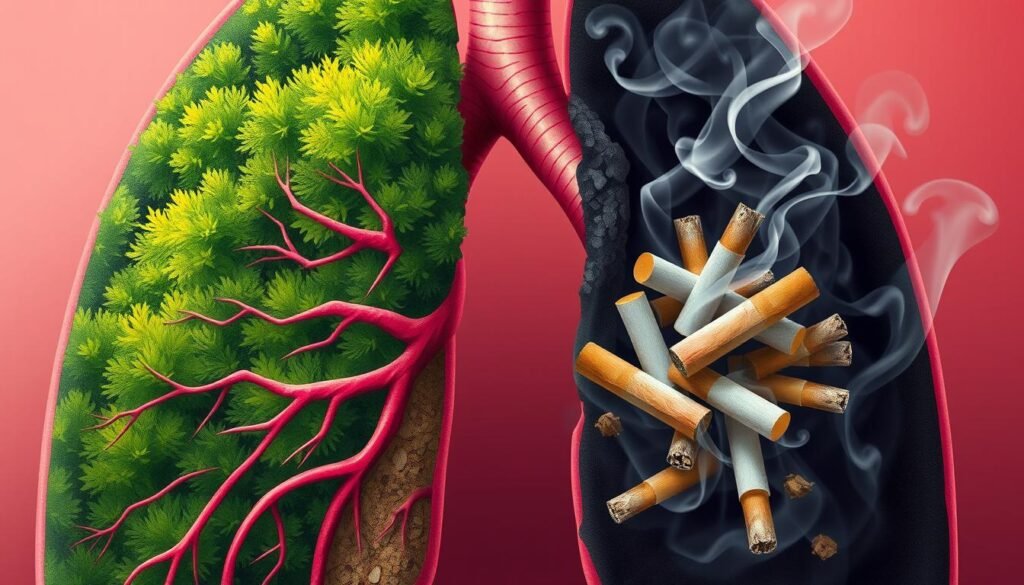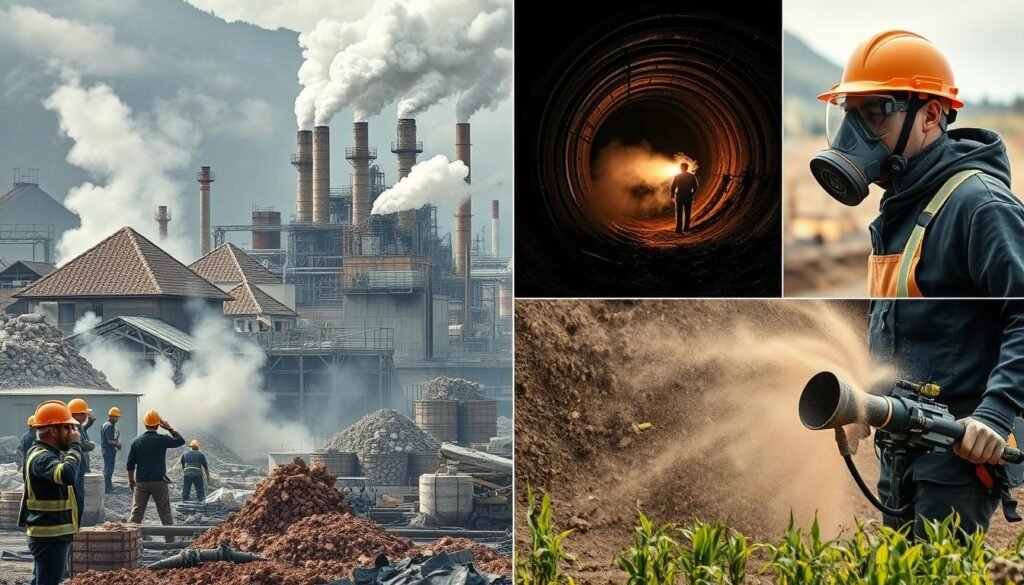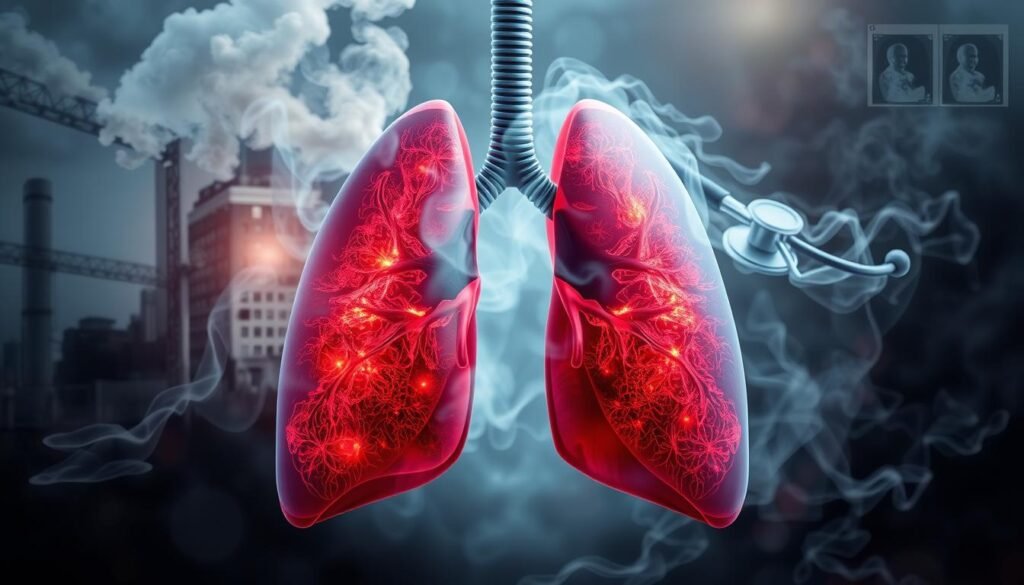Did you know about 80% of lung cancer deaths link back to smoking? This shows how crucial it is to know who might get lung cancer. Understanding who’s at risk and the reasons behind it is key. Lung cancer ranks as a top cause of cancer deaths globally, hitting some groups harder than others.
Knowing lung cancer signs and risk factors leads to early finding and better treatment results. This guide aims to help readers grasp these risk factors and signs. Knowing them makes it easier to decide when to seek a doctor’s opinion.
Key Takeaways
- Lung cancer is the leading cause of cancer deaths globally.
- Approximately 80% of lung cancer deaths are attributed to smoking.
- Secondhand smoke ranks as the third most common cause of lung cancer.
- Radon and asbestos exposure also significantly increase lung cancer risk.
- Early detection through understanding signs of lung cancer can enhance treatment outcomes.
Understanding Lung Cancer
Lung cancer is a serious condition where cells in the lungs grow abnormally. It’s important for breathing. This disease includes different conditions that affect health. Symptoms often don’t show up until it’s fairly advanced.
There are two main kinds of lung cancer: small cell (SCLC) and non-small cell (NSCLC). About 10% to 15% of cases are SCLC, known for being very aggressive. NSCLC is about 85% to 90% of cases and is slower to grow. Knowing the type is key to managing it well.
Most lung cancer cases, roughly 85%, are linked to smoking. Genes that change how we handle toxins and repair DNA also play a role. This shows why it’s crucial to prevent lung cancer and catch it early. For more information, check out this resource on lung cancer statistics.
Lung cancer is the top cause of cancer deaths worldwide. It’s about 18% of all cancer deaths, with over a million people dying each year. The situation sheds light on the major health challenge lung cancer is. It also points out the differences in how it affects men and African Americans. Knowing about lung cancer types is vital in combating this disease.
| Type of Lung Cancer | Percentage of Cases | Characteristics |
|---|---|---|
| Small Cell Lung Cancer (SCLC) | 10% to 15% | Aggressive; grows quickly |
| Non-Small Cell Lung Cancer (NSCLC) | 85% to 90% | Varies in growth rate; more common |
Primary Causes of Lung Cancer
It’s crucial to know what causes lung cancer, especially for those worried about their health. Smoking is the top cause, being behind about 90% of all cases. It introduces harmful substances into the lungs, which can lead to cancer.
Stopping smoking could prevent most lung cancer cases. Being around secondhand smoke is also dangerous, affecting even non-smokers. Then, there’s radon gas, the second biggest cause of lung cancer in the U.S. It’s thought that radon exposure happens in one out of every 15 homes.
About 30% of lung cancer deaths in non-smokers come from radon. Workplaces with harmful substances like asbestos and uranium add to the risk. These substances are linked with up to 80% of mesothelioma cases, a type of lung cancer.
Pollution from cars and trucks also plays a part in increasing risk. Family history might make someone more prone to getting lung cancer. For example, having family members with lung cancer doubles your risk. Certain vitamins may also up the risk for smokers.
Knowing about these risks can help people make better health choices. This awareness is key to prevention and maintaining good health.
Population at Risk for Lung Cancer
Some people have a higher chance of getting lung cancer due to their age and genes. Knowing about these factors helps with early cancer detection and prevention. This information is key to saving lives and promoting health.
Age as a Risk Factor
Older adults, especially those over 65, are more likely to get lung cancer. This group needs regular check-ups. Lung cancer cases are most common in this age group. Thankfully, the survival rate for lung cancer is now 28.4%.
This shows why finding the disease early is so important. Screenings are essential for older adults to catch cancer early.
Genetic Factors Contributing to Risk
Genes also play a big role in lung cancer risk. If lung cancer runs in your family, your risk increases. This makes genetic tests and being aware of your family’s health history crucial.
It’s important for families at risk to know and act to prevent lung cancer. Taking steps early can make a big difference for their future health.
The Impact of Smoking on Lung Cancer Risk
Smoking is the top reason for lung cancer, making up 70 to 90 percent of cases. It causes cellular damage that may lead to lung cancer. Smokers face a risk up to 30 times higher than non-smokers.
How Smoking Damages Lung Cells
Smoking introduces harmful substances into the lungs, causing inflammation. This increases the risk of diseases like COPD and lung cancer. Tobacco chemicals can alter DNA, leading to mutations and tumor growth. Smoking affects genes and makes different lung cancers more likely.
For example, male smokers often get squamous cell carcinoma. Women smokers are more likely to have adenocarcinoma.
Benefits of Quitting Smoking
Quitting smoking greatly lowers lung cancer risk. Your body starts to heal once you stop. Over time, former smokers can significantly reduce their lung cancer risk.
This helps lungs by reducing precancerous lesions and improving their function. While the risk doesn’t fully match that of never-smokers, quitting still offers a big benefit.
| Time Since Quitting | Reduction in Lung Cancer Risk |
|---|---|
| 1 Year | Approximately 42% chance of survival |
| 5 Years | Risk significantly lowered, although still higher than never-smokers |
| 10 Years | Much closer to the risk levels of never-smokers |

Secondhand Smoke Exposure
Secondhand smoke is a big public health concern. It’s especially linked to lung cancer risks. Children and non-smokers who are often in smoky places face more health dangers. Studies show being around secondhand smoke can lead to big health problems, not just lung issues. This risk is even higher for people exposed when they’re young.
Research shows a clear risk for people exposed to secondhand smoke at work or during fun times. If this exposure happens between birth and age 25, the odds ratio (AOR) for lung cancer is 1.30. This shows young people are more at risk. But, after age 25, the risk goes down. This means early exposure can have long-term effects. For non-smokers who grew up around smoke, the AOR is 1.29. This proves it’s crucial to protect young people from secondhand smoke.
Children are very prone to secondhand smoke’s harms. It can cause bad respiratory infections, worse asthma attacks, and even lower birth weights. Secondhand smoke causes over 7,300 lung cancer deaths yearly among non-smokers in the U.S. We urgently need to educate the public and take steps to protect them.
Laws reducing secondhand smoke exposure work well in developed countries. But tobacco companies still target young people with their ads. Creating smoke-free places is key. It keeps children safe from secondhand smoke and leads to healthier lives for everyone.
| Age of First Exposure | AOR for Lung Cancer | Vulnerable Groups |
|---|---|---|
| Birth to Age 25 | 1.30 (1.08-1.57) | Non-smokers, Children |
| After Age 25 | 0.66 (0.21-1.57) | Non-smokers, Current/Ex-smokers |
| Nonsmokers Exposure AOR (0-25) | 1.29 (0.82-2.02) | Nonsmokers |
| Nonsmokers Exposure AOR (25+) | 0.87 (0.22-3.38) | Nonsmokers |
Fighting secondhand smoke is vital for our health, especially for the most vulnerable. By promoting smoke-free zones, we can cut down secondhand smoke risks and boost overall health.
Occupational Hazards Linked to Lung Cancer
Lung cancer from job hazards is a big public health issue. It comes from being around workplace cancer-causing agents. Some jobs have a higher lung cancer risk because of these harmful substances. It’s important for bosses to keep workers safe. They can do this by making the workplace safer and using good safety actions.
Common Carcinogens in the Workplace
Many jobs put people at risk of lung cancer because of dangerous carcinogens. Important ones include:
- Asbestos: Often used in building and keeping heat in, asbestos is a known lung cancer cause.
- Arsenic: Found in mining and some making processes, arsenic raises cancer risk.
- Diesel Exhaust: Even a little exposure is risky for non-smokers, affecting millions around the world.
- Crystalline Silica: In stone cutting, mining, and building, exposure can cause lung cancer and other health problems.
- Nickel Compounds: People who work with nickel are at risk because of its cancer-causing properties.
Preventative Measures in Occupational Settings
To cut down the risk from occupational hazards, bosses need good safety plans. Important steps include:
- Having good ventilation in work areas to keep air clean.
- Giving workers the right protective gear, like masks, to prevent exposure.
- Checking workers’ health often to catch lung problems early.
- Teaching workers about hazards at work and how to stay safe.

Making these changes helps keep workers safe from lung cancer. Workplaces that focus on safety can lower the risk from these dangers. This makes a healthier workforce.
Environmental Factors Affecting Lung Cancer Risk
Environmental risk factors are crucial in lung cancer rates. Mainly, air pollution and radon exposure stand out. Knowing these can help lessen the risk.
The Role of Air Pollution
Air pollution is a big risk for lung cancer. Diesel truck exhaust, power plants, and wood smoke release harmful particles. These can harm lung tissues, upping the risk of disease.
Recent studies show particulate matter from pollution causes lung cancer. The WHO says air pollution is especially risky in poorer countries.
Radon Exposure in Homes
Radon is another big risk for lung cancer. This gas comes from uranium in soil and can build up in homes. Around 21,000 U.S. lung cancer deaths a year are due to radon. Testing for radon can cut health risks.
With air pollution, radon needs urgent attention to fight lung cancer.
| Environmental Factor | Risk Level | Impact on Lung Cancer |
|---|---|---|
| Air Pollution | High | Increases incidence due to lung tissue damage |
| Radon Exposure | Medium | Significantly contributes to lung cancer deaths |
| Secondhand Smoke | Medium | Raises risk for non-smokers significantly |
Chronic Lung Diseases and Their Connection to Lung Cancer
People with chronic lung diseases like Chronic Obstructive Pulmonary Disease (COPD) and asthma are more likely to get lung cancer. This is due to the ongoing inflammation and damage in the lungs that these conditions cause. Both COPD and lung cancer share symptoms such as coughing and difficulty breathing, making it hard to diagnose early.
The link between COPD and lung cancer is strong. Research shows those with COPD are four to six times more likely to develop lung cancer. This is a concern, showing the need for regular health checks. The risk is there, smoking or not, showing the complex relationship between these diseases.

On the other hand, asthma’s link to lung cancer tells a different story. If asthma is diagnosed early, it might lessen the risk of lung cancer. Still, the long-term inflammation from asthma can make lung tissue vulnerable.
Becoming aware and actively managing symptoms in chronic lung disease can lead to better health. Knowing how these diseases are connected helps in preventing and treating them early. For more on symptom overlap, check out key signs of COPD and lung.
Family History and Genetic Predisposition
Having a family history of lung cancer significantly increases your risk. If close relatives like parents or siblings have had lung cancer, you may have genetic risk factors. These factors can make you more likely to get lung cancer. Knowing about your family’s health history is very important. It helps doctors find ways to detect the disease early and monitor you closely.
Research into hereditary lung cancer is becoming very important. It has shown that certain genetic changes can raise your chances of getting lung cancer. The percentage of lung cancer cases with a family connection ranges from 2% to 46.8%. This means a large number of cases might be influenced by genetics. The habits families share, especially smoking, also play a role in these patterns.
Knowing your family’s health history can help you make smart choices for your health. If you have a strong family history of lung cancer, getting regular check-ups is vital. These steps, including talking to your doctor, can help catch the disease early. Catching it early can lead to better treatment results and improve your chances.
| Family History Factor | Impact on Lung Cancer Risk |
|---|---|
| Parents with Lung Cancer | Higher likelihood of genetic predisposition |
| Siblings with Lung Cancer | Increased risk of shared genetic mutations |
| Non-small cell lung cancer (NSCLC) Families | Higher rates of pathogenic germline variants |
| Smoking Habits in Family | Influences overall cancer risk among relatives |
In conclusion, understanding family history is key. It can lead you to make choices that reduce your lung cancer risk. Early detection and preventive steps are crucial benefits of this knowledge.
Signs and Symptoms of Lung Cancer
Lung cancer often starts without warning, which makes spotting it early tough. Knowing the signs and symptoms can really make a difference in getting the right treatment quickly. It’s very important to catch lung cancer early for better chances at treatment.
Early Symptoms to Watch For
It’s key to watch out for certain lung cancer symptoms. Some early warning signs include:
- Persistent cough lasting over eight weeks
- Unexplained weight loss
- Shortness of breath, especially during daily activities
- Recurring respiratory infections
Being aware of these symptoms is crucial. A lasting cough or unexpected weight loss are big red flags. Catching these early signs of lung cancer quickly could lead to early diagnosis. And that means better options for treatment.
Symptoms When Cancer Spreads
When lung cancer gets worse, the symptoms can get severe. This could mean the cancer has spread. Signs of advanced stages might include:
- Wheezing or having trouble breathing
- Coughing up blood
- Chest pain or pain that spreads to the back
- Hoarseness
Knowing these severe symptoms is key. It shows why it’s urgent to get medical help if they start. If you act fast, you can get checked out right away. For more on spotting lung cancer symptoms, check out this resource.
| Symptom | Description |
|---|---|
| Chronic Cough | Lasting over eight weeks; may indicate underlying issues. |
| Weight Loss | Unexplained loss of weight can be a red flag for cancer. |
| Shortness of Breath | Difficulty breathing during daily activities may signal lung issues. |
| Coughing Up Blood | A concerning symptom that requires immediate medical attention. |
Recognizing these signs promptly can lead to quick action and possibly save lives.
When to Seek Medical Advice
Knowing the signs of lung cancer is key to early care. Look out for constant symptoms. A long-lasting cough, breathing difficulties, and spitting blood are major signs. If you notice these, see a doctor quickly. Acting fast can lead to better treatment results. It’s crucial to know when it’s time to get medical help.
The American Cancer Society advises certain people to get checked every year. This is for those aged 50 to 80 who smoked a lot in the past. Even if you’ve stopped smoking, you could still be at risk. Making regular health checks a habit is very important.
Talk to a doctor if you notice anything unusual about your health. They might suggest different tests to figure out the best treatment plan. This could happen if lung cancer is found. It’s vital to seek advice as soon as symptoms appear. This ensures the best care for lung cancer.
Conclusion
Knowing about lung cancer risk is very important. It helps people take charge of their health. In 2018, the world saw around 2.1 million new cases of lung cancer. This makes learning about its signs and early-warning signals very important.
Factors like smoking, being around smoke from others, and harmful environmental factors play a big role. Understanding these can help people avoid lung cancer. This is a key step in staying healthy.
Lung cancer is still the top cause of death from cancer across the globe. It’s responsible for 20% of all cancer deaths. This shows how vital it is to be aware of factors that affect who gets lung cancer. Knowing this can lead to taking action to stay safe from cancer causes.
It’s critical to focus on stopping lung cancer before it starts and encouraging people to get screened early. Right now, only 19% of people diagnosed with lung cancer live longer than 5 years. But finding and treating it early can change that.
Doctors and communities are working to tackle lung cancer risks. Their goal is to lessen its toll. For more detail on how to fight lung cancer, click here.